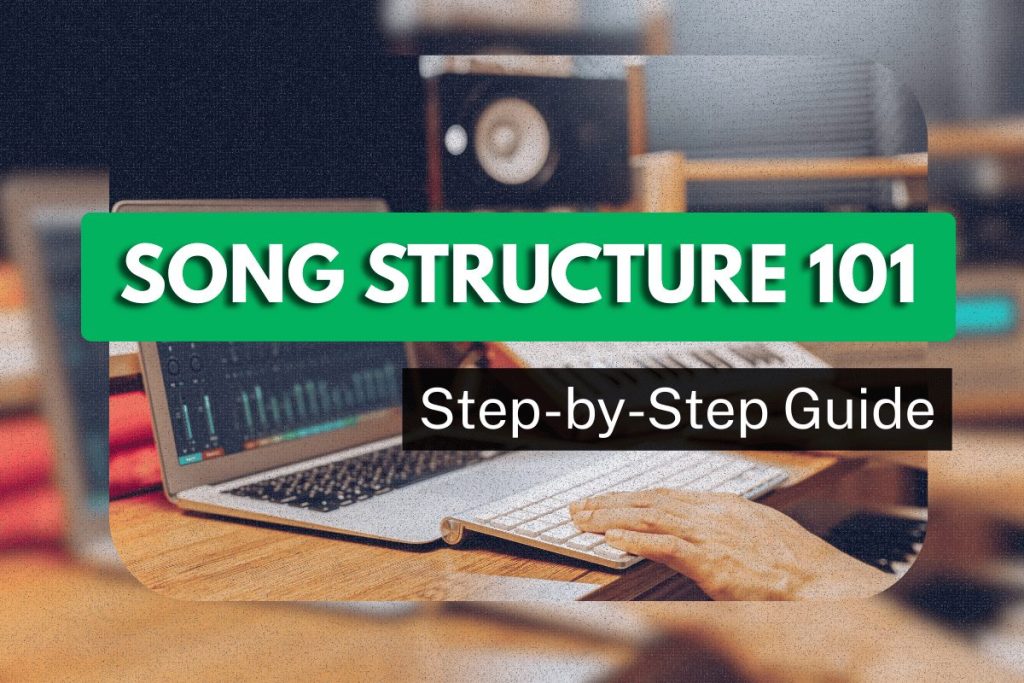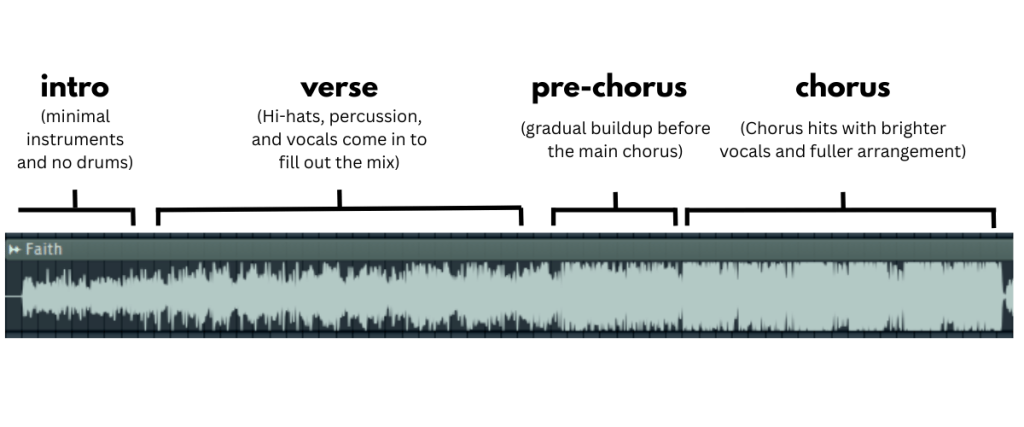Writing a song is more than just the melody or lyrics. What transcends the idea of a good melody or lyrics is how the song is arranged. You’ve probably heard how famous musicians write their songs in such a way that it feels captivating every second. This is because of good song arrangement. Mastering good music structure allows every portion of the section to kick in at the right times. In this comprehensive blog, you will learn how to structure a song effectively. The blog will provide a hands-on guide to help you produce the next hit.

Table of Contents:
Why is structuring a song important?
Components of a song with examples
What is Song Arrangement?

Song arrangement refers to the way different musical elements are structured in a particular composition. Whether it’s vocals, instruments, or melody. It essentially involves selecting the order of each section (like verse, chorus, or bridge) and shaping the song’s flow from start to finish.
For example, before reaching the main part of a song, an introduction would be followed by a verse. This helps to give the song a natural flow. Some songs even begin with the chorus to create a stronger hook. A well-crafted song arrangement helps the listener stay engaged, clarifies the message, and lends your music a professional feel.
Why is structuring a song important?
A great melody or a great voice cannot help in retaining listeners if a song is not structured properly. The intro pulls listeners in, the verse tells the story, and the chorus delivers the main message. The overall music structure is what keeps listeners hooked in.
Think of a song like a journey. If the parts are out of order or too repetitive, people might lose interest. But with the right flow, your song feels natural and easy to follow.
Also, structure makes your song easier to record, perform, and share. It helps you build emotion, create tension, and deliver a strong impact.
Components of a song with examples
Intro
The intro is the starting part of a song. It sets the mood and gives listeners a taste of what’s coming. It might include a short melody, a beat loop, or a simple chord progression. Some intros are just a few seconds long, while others slowly build into the first verse. Most often, there are no vocals yet.
Listen to the intro of “Linger” by The Cranberries. It sets a soft, melancholic tone right from the start. It begins with a gentle string section and light guitar picking, creating a dreamy, almost fragile atmosphere.
Verse
The verse is where the story begins. It usually has new lyrics each time it appears, but keeps the same melody. Verses give details, describe emotions, or build up the message. They come before the pre-chorus and help move the song forward. A song typically has two or more verses placed between choruses.
For example, In “Creep” by Radiohead, the verse begins with soft, almost whisper-like vocals with minimal Instrumentation.
Pre-chorus
The pre-chorus comes right after the verse and just before the chorus. It builds energy and creates a smooth transition. This section often sounds a little different from the verse and sets up the big moment—the chorus. Not every song has a pre-chorus, but when used, it adds tension and makes the chorus hit harder.
Chorus
The chorus is the heart of the song. It’s the part that repeats and usually carries the main message or hook. Choruses are often louder, catchier, and more emotional than verses. They stay the same each time and are easy to remember.
For instance, if you give Tame Impala’s “New Person, Same Old Mistakes” a listen, the chorus is filled with rich synth textures with strong vocals.
Bridge
The bridge plays an important role in breaking the pattern of verses and chorus. It’s a big contrast to keep things interesting. The bridge adds emotion, surprise, or tension before the final chorus. It helps keep the song from feeling too repetitive.
Outro
The outro is what gives the song a proper finish. Otherwise, there would be an abrupt end to the song. Just like the intro, the outro features minimal song elements with a gradual fadeout.
If you listen to the outro of Rag’n’Bone Man’s“Human”, you would hear mellow synth with vocals gently repeating the main hook.
Common Song Structures You Can Try
Learning how to structure a song is easier when you start with tried-and-tested formats. Here are three beginner-friendly structures you can build right away.
1. Verse – Chorus – Verse – Chorus – Bridge – Chorus
This is the most common song structure. It gives your song a clear flow and emotional rise.
How to build it:
- Start with a verse: Write 4–8 lines that introduce your story.
- Add a chorus: Make it short, repeatable, and emotionally strong. Use your song title here.
- Repeat the verse with lyric changes.
- Add a bridge: Try a new melody or chord change to surprise the listener.
- Return to the final chorus for a strong ending.
Example:
A song about leaving your hometown. The verse describes the place, the chorus focuses on the decision to leave, and the bridge reflects on what you’ll miss.
2. Verse – Pre-Chorus – Chorus – Verse – Pre-Chorus – Chorus
This structure adds a pre-chorus to build tension before the hook.
How to build it:
- Write a verse that sets the scene.
- Add a short pre-chorus with rising melody or mood.
- Drop into a catchy chorus that feels big and satisfying.
- Repeat and build.
Example:
Verse talks about working late nights, pre-chorus builds tension (“this can’t be it”), chorus expresses the desire for change.
3. Chorus – Verse – Chorus – Bridge – Chorus
This grabs attention by starting with the chorus.
How to build it:
- Write your chorus first—it should be strong and clear.
- Then go into a verse to explain the backstory.
- Repeat the chorus and insert a short bridge for contrast.
Example:
Chorus repeats “I need a sign,” verse describes small daily struggles, bridge asks whether it’s time to move on.
FAQ
What are the most common song structures?
The most common song structure is:
- Verse – Chorus – Verse – Chorus – Bridge – Chorus
- Chorus – Verse – Chorus – Bridge – Chorus
What is the most famous song structure?
The most famous structure is: Verse – Chorus – Verse – Chorus – Bridge – Chorus
How do I identify the structure of a song?
- Listen for repeating parts (chorus usually repeats exactly).
- Notice where the lyrics change (verses) vs. where they stay the same.
- Pay attention to musical changes, like a new section or mood shift (often a bridge).
- Label sections as you listen: Verse (V), Chorus (C), Bridge (B), etc.
Conclusion
Understanding song arrangement helps you turn scattered ideas into a complete, flowing song. You don’t need complex theory just a clear structure and some creativity. Begin with simple formats, experiment with different sections, and build upon them. Whether you’re writing your first song or refining a demo, good structure makes your music more powerful and easier to connect with. Keep it simple, stay consistent, and trust your ears.
